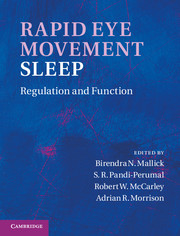Book contents
- Frontmatter
- Contents
- Contributors
- Preface
- Acknowledgments
- Organization
- Section I Historical context
- Section II General biology
- Section III Neuronal regulation
- Section IV Neuroanatomy and neurochemistry
- Section V Functional significance
- 30 Significance of deprivation studies
- 31 Modulation of body core temperature in NREM sleep and REM sleep
- 32 Sleep-related hippocampal activation: implications for spatial memory consolidation
- 33 The role of REM sleep in memory consolidation, enhancement, and integration
- 34 The role of REM sleep in emotional brain processing
- 35 REM-sleep loss, oxidative damage, and apoptosis
- 36 The role of REM sleep in maintaining neuronal excitability and its possible mechanism of action
- 37 Comparison of REM sleep-deprivation methods: role of stress and validity of use
- 38 REM sleep in patients with depression
- 39 Proteins and neuropeptides in REM-sleep regulation and function
- Section VI Disturbance in the REM sleep-generating mechanism
- Index
- Plate section
- References
32 - Sleep-related hippocampal activation: implications for spatial memory consolidation
from Section V - Functional significance
Published online by Cambridge University Press: 07 September 2011
- Frontmatter
- Contents
- Contributors
- Preface
- Acknowledgments
- Organization
- Section I Historical context
- Section II General biology
- Section III Neuronal regulation
- Section IV Neuroanatomy and neurochemistry
- Section V Functional significance
- 30 Significance of deprivation studies
- 31 Modulation of body core temperature in NREM sleep and REM sleep
- 32 Sleep-related hippocampal activation: implications for spatial memory consolidation
- 33 The role of REM sleep in memory consolidation, enhancement, and integration
- 34 The role of REM sleep in emotional brain processing
- 35 REM-sleep loss, oxidative damage, and apoptosis
- 36 The role of REM sleep in maintaining neuronal excitability and its possible mechanism of action
- 37 Comparison of REM sleep-deprivation methods: role of stress and validity of use
- 38 REM sleep in patients with depression
- 39 Proteins and neuropeptides in REM-sleep regulation and function
- Section VI Disturbance in the REM sleep-generating mechanism
- Index
- Plate section
- References
Summary
Summary
Sleep is implicated in the consolidation of many types of learning and memory tasks. Place cells (hippocampal neurons responding to spatial location of the subject) associated with novel environments on a spatial task reactivate during subsequent sleep (Poe et al., 2000). Such neuronal firing is thought to strengthen memories formed during waking exploration (Huerta and Lisman, 1995). Once the initially novel environment becomes familiar to the animal, place cells reverse phase at which they fire with respect to local theta oscillations during REM sleep. Such phase-reversed firing during theta is consistent with patterns that induce the depotentiation of previously potentiated synapses. Depotentiation is important to prevent the saturation of synaptic weights in the hippocampus, keeping the differential weighting structure necessary for memory preservation. These results indicate that sleep in general seems to serve neither an overall synaptic erasing (Tononi and Cirelli, 2001) nor a general synaptic amplification effect. Rather, in a network-by-network manner (Ribeiro and Nicolelis, 2004) and, according to the requirements of the learning phase, REM-sleep reactivation serves to amplify as-yet-unconsolidated memories and erase already transferred networks from the temporary stores of the hippocampus (Best et al., 2007; Booth and Poe, 2006).
- Type
- Chapter
- Information
- Rapid Eye Movement SleepRegulation and Function, pp. 319 - 327Publisher: Cambridge University PressPrint publication year: 2011



